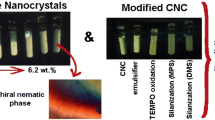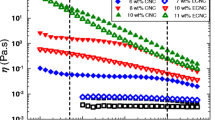Abstract
The effect of ionic strength on the rheology and microstructure of Cellulose nanocrystals (CNC) aqueous suspensions are studied over a broad range of CNC (3–15 wt%) and NaCl concentrations (0–15 mM), using polarized optical microscopy combined with rheometry. The CNC suspensions are isotropic at low concentration and form chiral nematic liquid crystalline structure above a first critical concentration and gel above a second critical one. It has been shown that for isotropic CNC suspensions, increasing the ionic strength of the system up to 5 mM NaCl concentration weakens the electro-viscous effects and thus reduces the viscosity of these suspensions. For biphasic samples, which contain chiral nematic liquid crystal domains, increasing the ionic strength up to 5 mM NaCl concentration decreases the size of the chiral nematic domains, and leads the viscosity of the samples at low shear rates to increase. On the other hand, at high shear rates, where all the ordered domains are broken, the viscosity decreases with NaCl addition. For gels, the addition of NaCl up to 5 mM weakens the gel structure and decreases the viscosity. Further addition of NaCl (10 and 15 mM NaCl concentrations) results in extensive aggregation and de-stabilizes the CNC suspensions.













Similar content being viewed by others
References
Araki J, Kuga S (2001) Effect of trace electrolyte on liquid crystal type of cellulose microcrystals. Langmuir 17:4493–4496
Araki J, Wada M, Kuga S, Okano T (1999) Influence of surface charge on viscosity behavior of cellulose microcrystal suspension. J Wood Sci 45:258–261
Araki J, Wada M, Kuga S, Okano T (2000) Birefringent glassy phase of a cellulose microcrystal suspension. Langmuir 16:2413–2415
Beck-Candanedo S, Roman M, Gray DG (2005) Effect of reaction conditions on the properties and behavior of wood cellulose nanocrystal suspensions. Biomacromolecules 6:1048–1054
Bercea M, Navard P (2000) Shear dynamics of aqueous suspensions of cellulose whiskers. Macromolecules 33:6011–6016
Boluk Y, Lahiji R, Zhao L, McDermott MT (2011) Suspension viscosities and shape parameter of cellulose nanocrystals (CNC). Colloids Surf A Physicochem Eng Asp 377:297–303
Dong XM, Gray DG (1997) Effect of counterions on ordered phase formation in suspensions of charged rodlike cellulose crystallites. Langmuir 13:2404–2409
Dong XM, Kimura T, Revol JF, Gray DG (1996) Effects of ionic strength on the isotropic-chiral nematic phase transition of suspensions of cellulose crystallites. Langmuir 12(8):2076–2082
Dong XM, Revol JF, Gray DG (1998) Effect of microcrystallite preparation conditions on the formation of colloid crystals of cellulose. Cellulose 5:19–32
Gonzalez-Labrada E, Gray D (2012) Viscosity measurements of dilute aqueous suspensions of cellulose nanocrystals using a rolling ball viscometer. Cellulose 19:1557–1565
Hamad WY, Hu TQ (2010) Structure-process-yield interrelation in nanocrystalline cellulose extraction. Can J Chem Eng 88(3):392–402
Hirai A, Inui D, Horii F, Tsuji M (2009) Phase separation behavior in aqueous suspensions of bacterial cellulose nanocrystals prepared by sulfuric acid treatment. Langmuir 25:497–502
Liu D, Chen X, Yue Y, Chen M, Wu Q (2011) Structure and rheology of nanocrystalline cellulose. Carbohydrate Polymer 84:316–322
Liu D, Li J, Sun F, Xiao R, Guo Y, Song J (2014) Liquid crystal microphase seperation of cellulose nanocrystals in wet-spun PVA composite fibers. RSC Adv 4:30784–30789
Marchessault RH, Morehead FF, Walter NM (1959) Liquid crystal systems from fibrillar polysaccharides. Nature 184:632–633
Marchessault RH, Morehead FF, Koch MJ (1961) Some hydrodynamic properties of neutral suspensions of cellulose crystallites as related to size and shape. J Colloid Sci 16:327–344
Odijk T (1986) Theory of lyotropic liquid crystals. Macromolecules 19:2313–2329
Onogi S, Asada T (1980) In rheology and rheo-optics of polymer liquid crystals. In: Astarita G, Marrucci G, Nicolais L (eds) Proceedings of the eighth international congress on rheology. Plenum Press, Napoles, pp 126–136
Onsager L (1949) The effect of shape on the interactions of colloid particles. Ann N Y Acad Sci 51:627–659
Orts WJ, Godbout L, Marchessault RH, Revol JF (1998) Enhanced ordering of liquid crystalline suspensions of cellulose microfibrils: a small angle neutron scattering study. Macromolecules 31:5717–5725
Ranby BG (1951) The colloidal properties of cellulose micelles. Discuss. Faraday Soc 11: 158–164, discussion 208-213
Revol JF, Marchessault RH (1994) In vitro chiral nematic ordering of chitin crystallites. Int J Biol Macromol 15:329–335
Revol JF, Bradford H, Giasson J, Marchessault RH, Gray DG (1992) Helicoidal self-ordering of cellulose microfibrils in aqueous suspension. Int J Biol Macromol 14(3):170–172
Shafiei-Sabet S, Hamad WY, Hatzikiriakos SG (2012) Rheology of nanocrystalline cellulose aqueous suspensions. Langmuir 28:17124–17133
Shafiei-Sabet S, Hamad WY, Hatzikiriakos SG (2013) Influence of degree of sulfation on the rheology of cellulose nanocrystal suspensions. Rheol Acta 52:741–751
Tatsumi D, Ishioka S, Matsumoto T (1999) Effect of particle and salt concentrations on the rheological properties of cellulose fibrous suspensions. Nihon Reoroji Gakkaishi 27:243–248
Urena-Benavides EE, Ao G, Davis VA, Kitchens CL (2011) Rheology and phase behavior of lyotropic cellulose nanocrystal suspensions. Macromolecules 44:8990–8998
Winter HH, Chambon F (1986) Analysis of linear viscoelasticity of a crosslinking polymer at the gel point. J of Rheology 30(2):367–382
Acknowledgments
The authors would like to acknowledge NSERC and FPInnovations for financial support under grant CRD-379851-2008.
Author information
Authors and Affiliations
Corresponding authors
Rights and permissions
About this article
Cite this article
Shafiei-Sabet, S., Hamad, W.Y. & Hatzikiriakos, S.G. Ionic strength effects on the microstructure and shear rheology of cellulose nanocrystal suspensions. Cellulose 21, 3347–3359 (2014). https://doi.org/10.1007/s10570-014-0407-z
Received:
Accepted:
Published:
Issue Date:
DOI: https://doi.org/10.1007/s10570-014-0407-z




